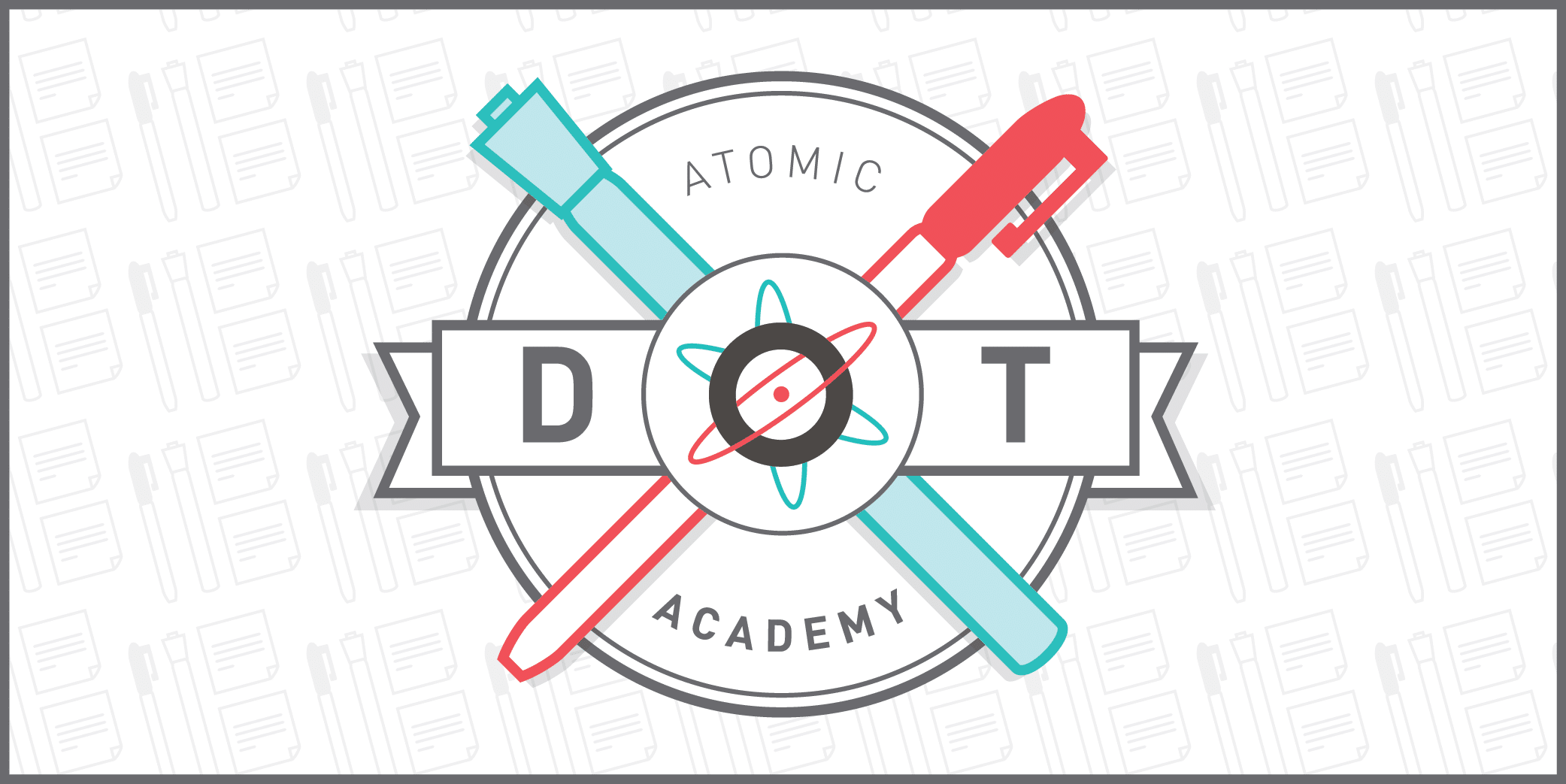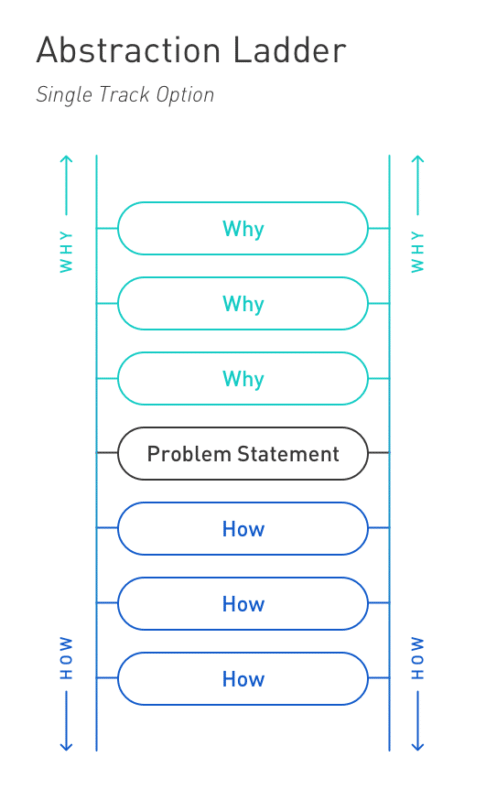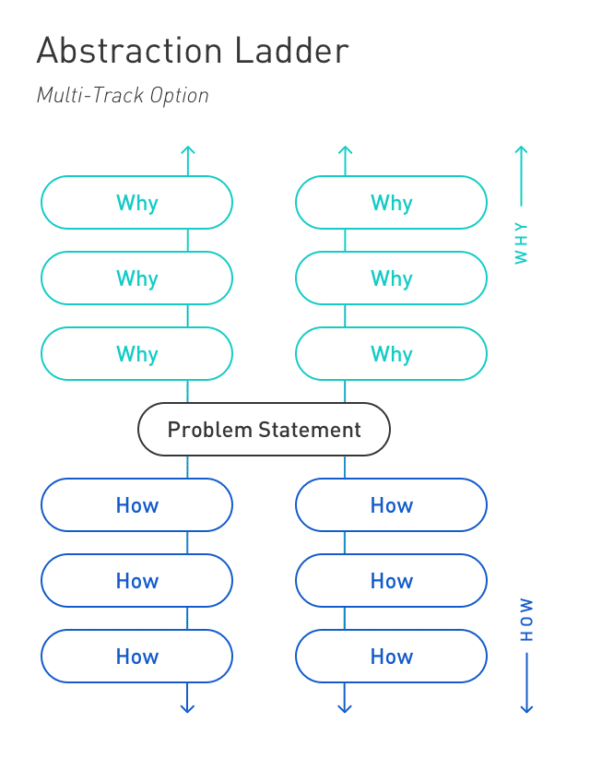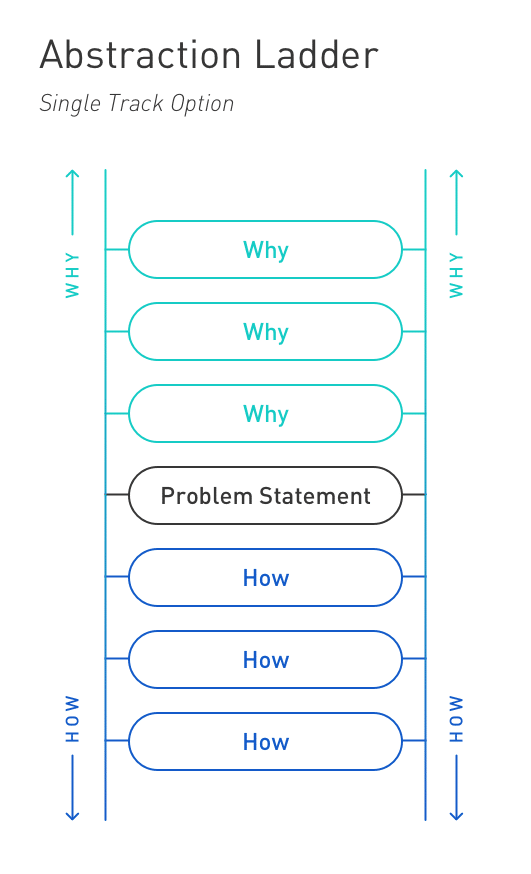Article summary

Let’s ascend to new levels of thinking with Abstraction Ladder, a method that will help you find the true meaning, purpose, or potential of a concept or the root cause of a problem.
| Primary Goal | To deeply explore the why and how of a concept or idea |
| When to Use | When trying to validate an idea |
| Time Required | 20-40 minutes |
| Number of Participants | 1-10+ |
| Who Should Participate? | Any members of the team |
| Supplies | Whiteboard, PostIt notes, Sharpies |
Have you ever noodled on a problem and felt like you were only scratching the surface? That no matter what solution you ideated, it wasn’t addressing the real problem? If you’ve felt this before, Abstraction Ladder is the activity for you. (This activity was created by S. I. Hayakawa in his 1939 book “Language in Thoughts and Action.”)
This method draws out the hows and whys of a problem and allows you to analyze each step along the way. Beginning with a starter or challenge statement, you set the stage for your ladder. As you move up each rung of the ladder, you define the problem’s more abstract or broad aspects. As you move down the ladder, you define its more concrete or narrow attributes. Then, after each rung is complete, you circle back and determine which area(s) should be the focus for your project.
 Here’s an example (click to enlarge). Notice how items closest to the problem statement are vaguer, and as they get closer to the ends of the ladder, they become more specific. This is the overall goal of the activity — to drive towards specificity so that you can understand the heart of your problem statement’s whys and hows.
Here’s an example (click to enlarge). Notice how items closest to the problem statement are vaguer, and as they get closer to the ends of the ladder, they become more specific. This is the overall goal of the activity — to drive towards specificity so that you can understand the heart of your problem statement’s whys and hows.
Setup
Begin by choosing a problem to tackle. You may choose to wordsmith the precise Problem Statement during the activity itself.
You also need to choose between a single-track or a multi-track ladder.

The single-track ladder offers a way to focus on one line of thinking. Use this setup when your problem is already paired down quite a bit.

With complex problems, it helps to think through multiple tracks at the same time. This also helps to compare and contrast different focus areas and identify common patterns. Use the multi-track ladder when the problem is quite large.
Run the Activity!
- Orient your group to the problem statement (or work with them to refine it).
- If you’re working with a large group of folks, break them into smaller groups of 2-4 people.
- Start moving up the ladder by asking “why?” As the group progresses up each run of the ladder the statements should become increasingly more abstract. Usually heading up 3-4 rungs provides enough information, but keep going if further “whys” are found.
- Head down the ladder by asking “how?” These statements should be focused, specific versions of your problem statement. This will narrow the focus of the problem and as you continue down the statements should become increasingly specific.
- After the group has completed their ladder(s), take a step back, and take stock of any new ideas or patterns that have emerged.
- Move up or down the ladder, choosing a new focus point for the project.
Have each participant share their thoughts and ideas. Encourage discussion, with each idea being the jumping-off point for others.
Atomic’s Design Thinking Toolkit
- What Is Design Thinking?
- Your Design Thinking Supply List
- Activity 1 – The Love/Breakup Letter
- Activity 2 – Story Mapping
- Activity 3 – P.O.E.M.S.
- Activity 4 – Start Your Day
- Activity 5 – Remember the Future
- Activity 6 – Card Sorting
- Activity 7 – Competitors/Complementors Map
- Activity 8 – Difficulty & Importance Matrix
- Activity 9 – Rose, Bud, Thorn
- Activity 10 – Affinity Mapping
- Activity 11 – Speed Boat
- Activity 12 – Visualize The Vote
- Activity 13 – Hopes & Fears
- Activity 14 – I Like, I Wish, What If
- Activity 15 – How to Make Toast
- Activity 16 – How Might We…?
- Activity 17 – Alter Egos
- Activity 18 – What’s On Your Radar?
- Activity 19 – The Perfect Morning
- Activity 20 – 2×3
- Activity 21 – How Can I Help…?
- Activity 22 – Cover Story
- Activity 23 – Crazy 8s
- Activity 24 – Abstraction Ladder
- Activity 24 – Abstraction Ladder
- Activity 25 – Empathy Map
- Activity 26 – Worse Possible Idea
- Activity 27 – Pre-Project Survey
- Activity 28 – The Powers of Ten
- Activity 29 – SCAMPER
- Activity 30 – Design Studio
- Activity 31 – Forced Connections

